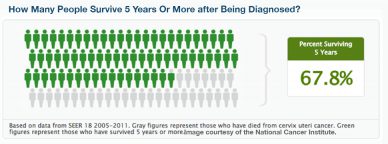Cervical Cancer
Cervical cancer at a glance
- Cervical cancer is caused by abnormal cell growth resulting in a cancerous tumor in the cervix.
- It is the second most common type of cancer in women.
- However, it is one of the few cancers that is highly preventable with regular Pap smears for early screening and with a human papillomavirus (HPV) vaccination.
- Early stages of cervical cancer may have few symptoms or no symptoms at all.
- Treatment may include surgical removal of the tumor or ovaries, chemotherapy and radiation therapy.
What is cervical cancer?
Cervical cancer is a cancerous growth that starts in the cells lining the cervix. The cervix is the lower, narrow end of the uterus (or womb) and is part of a woman’s reproductive system. Cervical cancer is a slow-forming cancer, sometimes taking years to develop from abnormal cells in the lining of the cervix to cancerous growths.
Cervical cancer is the second most common type of cancer for women, affecting about 12,000 people a year. But it is also one of the most preventable types of cancer due to screening tests and vaccinations for the human papillomavirus (HPV), a sexually transmitted disease that is the highest risk factor for developing cervical cancer.
Pap smear tests can detect cervical pre-cancer before it becomes cancerous. Doctors recommend that women start getting Pap screens after age 20.
The three vaccines against the strains of HPV that cause cervical cancer can prevent cervical cancer from forming if a woman has the HPV strain. These vaccinations are recommended for girls before they become sexually active and for women age 13–26 who have not completed the full series of vaccinations. Typically, girls age 11–12 are encouraged to get vaccinated.
Like many cancers, if left untreated or undiagnosed, cervical cancer can spread to other parts of the body over time. This process is called metastasis.
What causes cervical cancer?
The exact cause of cervical cancer is not known. But HPV infection plays a major role, with long-lasting HPV infections causing the most cases of cervical cancer. A HPV infection is typically passed through sexual contact. It is common in women and men, and usually affects sexually active women under age 20.
Not all women with HPV infections, however, develop cervical cancer.
Of the more than 100 different types of HPV infections, only two types, HPV 16 and HPV 18, are strongly associated with cervical cancer. The majority of HPV infections are considered low-risk for cervical cancer. The body’s immune system fights off most HPV infections. However, HPV doesn’t go away and it can lead to cancer years after a woman is infected with the virus.
Other possible risk factors for cervical cancer include:
- Smoking
- STDs, such as chlamydia, gonorrhea, syphilis
- HIV/AIDS
- Reduced immunity
- Having sex at an early age
- Having many sex partners (the more partners the greater the risk)
- Long-term birth control pill or IUD use
- A family history of cervical cancer
- Having three or more pregnancies.
Although these risk factors increase the odds of developing cervical cancer, having a risk factor doesn’t mean that a woman will develop this disease.
Cervical cancer symptoms
There are usually no signs or symptoms of early cervical cancer. Symptoms of late stage cervical cancer may include:
- Vaginal bleeding
- Pain during sexual intercourse
- Bleeding after sexual intercourse
- Abnormal menstrual cycles (longer of heavier than before).
Cervical cancer testing, diagnosis and treatment
The earlier cervical cancer is detected, the better the outcome of treatments. Screening tests can greatly reduce the risk of cervical cancer. Pap smears check for abnormal cells in the cervix, indicating cancer. An HPV DNA test can check for HPV cells that may develop into cervical cancer later. These cells can then be treated before cancer forms.
The American Cancer Society recommends that all women should begin cervical cancer screening at age 21. Women aged 21–29 should have a Pap test every three years, and women over age 30 should have an HPV test every five years.
 Women who have had a total hysterectomy (removal of the uterus and cervix) can stop screening unless the hysterectomy was done as a treatment for cervical cancer or pre-cancer. Women who have had a hysterectomy without removal of the cervix should continue cervical cancer screening as recommended by their physician.
Women who have had a total hysterectomy (removal of the uterus and cervix) can stop screening unless the hysterectomy was done as a treatment for cervical cancer or pre-cancer. Women who have had a hysterectomy without removal of the cervix should continue cervical cancer screening as recommended by their physician.
When diagnosing cervical cancer, physicians may perform the following procedures:
- Cervical cytology (Pap smear)
- HPV test
- Endocervical curettage, biopsy of mucous membranes in the cervix
- Colposcopy, magnified view of the cervix, vulva and vagina
- Biopsy of other tissue.
Treatment may include a combination of surgery (including a full or partial hysterectomy), chemotherapy or radiation therapy. These treatments either remove the cancerous growths or kill off the cells causing the cancer.
The type of treatment depends on the size of the tumor, whether the cancer has spread and whether the patient would like to become pregnant someday.